Twisting and climbing plants are a unique, inimitable toolkit in landscape design. They give the site coziness, comfort, aesthetic appearance of the entire territory. They also perform additional functions: house walls protection, a hedge protects the building from street noise, various pollution, and disguises unsightly buildings in the yard. To these advantages can be added absolute ease of maintenance.
Among them are perennial species, annuals, evergreen and flowering, decorative and even fruiting, rapidly growing. Let’s get acquainted with the best climbing plants for house walls.
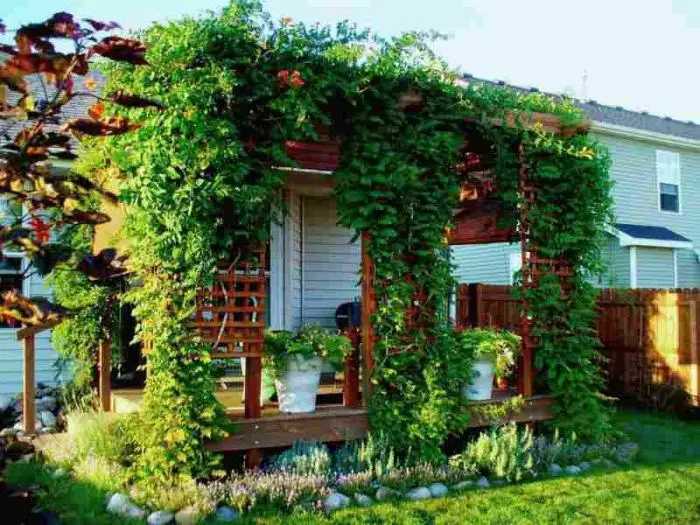
How to choose limbing plants for house walls
If you wanted to be a landscape designer, feel free to get down to business. There is nothing difficult and impossible in the process. The main thing is to have a desire and adhere to small rules.
The planning of planting climbing plants must be familiar with the range of their flowering. The hedge will look very beautiful if some varieties fade, and other blooming species come to replace them. From early spring to late autumn, you are provided with a vibrant and varied environment of flowers.
It is not recommended to plant bushes quite close to the walls of buildings. The root system of plants must have a certain amount of soil for strengthening. For this, 20-25 cm from the landing site to the support is enough.
You should also pay attention to the gap between the seedlings. Do not think that by planting densely plants, you will immediately get the desired result – a green hedge.
Maintain the distance between the roots at 1.5-2 meters. In this case, the vine, leaves and flowers will receive enough light, nutrients, moisture. The result is an unrivaled view of a braided fence.
Each specific plant requires individual feeding. Therefore, apply the necessary fertilizer to the hole before planting.
Pay attention to where the climbing plants are planted. Do not place them too close to drainpipes, electrical wires or lightning rods. So you can avoid damage to communications by loaches.
These recommendations will help you in improving the site. Let’s get acquainted with each species separately.
11 Best Climbing Plants For House Walls
There are varieties that are striking in their growth rate, allowing you to achieve the desired result in one season. Among them are:
- Fallopia Aubert (popularly – buckwheat);
- clematis;
- curly rose;
- ordinary hops;
- kirkazon;
- honeysuckle;
- woodworm;
- ivy;
- actinidia;
- girlish grapes.
FALLOPIA AUBERT
Fallopia Aubert is a representative of the fastest growing vines. Snow-white small flowers in the upper part of the stem are collected in a brush. There are quite a few of them, which gives the fence an elegant look. Blooms from August to October. For a year, the vine grows by 8 meters and over time can reach 15 meters.
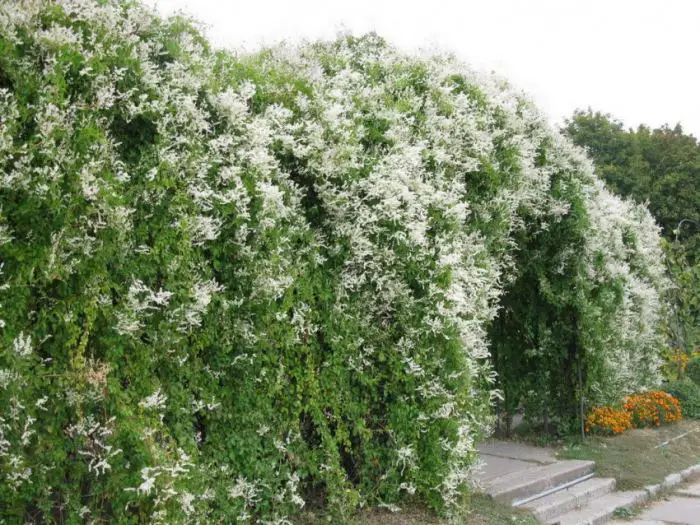
It is preferable to plant the vine in well-drained, fertile soil. Medium soils may also work. Grows well in temperate climates.
However, severe winters lead to freezing, but after pruning it regenerates rather quickly. For planting, you should choose sunny places or a little partial shade.
This climbing plant is the most successful option for decorating a fence, decorating a gazebo and the trunks of old trees.
Want to know about Are Essential Oils Safe For Plants.
CLEMATIS
Not lagging behind buckwheat and clematis variety Bill Mackenzie. This plant adds 5-6 meters per year, and it takes eight weeks to cover the fence with beautiful greenery with gorgeous bright yellow bells.
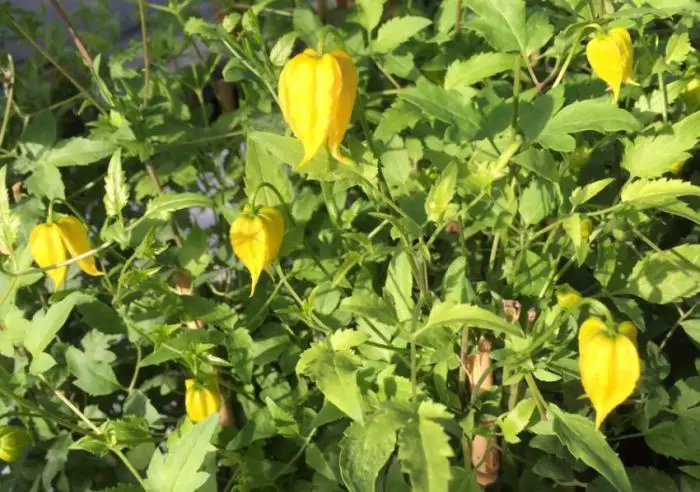
High walls and an old building framed by this vine look extraordinary. The leaves remain green until late autumn, blooming almost all summer until the end of October. From July, fluffy seed fruits are added to the yellow flowers, which add decorativeness to the bordering objects.
The plant is frost-hardy and not very demanding. Drought tolerates quite easily. You need to pay attention to the lighting. The plant thrives on sunny spots.
CURLY ROSE
These flowers will not leave anyone indifferent. Their continuous flowering, stunning aroma, as well as excellent health among gardeners occupy the highest step. The unique shrub is divided into two groups:
- ramblers – fast-growing, wild-like roses that bloom several times a year; reach 8 meters;
- climbers – present numerous large bouquets of small flowers capable of climbing supports and fences; sufficiently resistant to disease.

The difference between these shrubs is in the form: in ramblers, the stems are flexible and long (you cannot do without support), and in climbers they are thick and tough, grow straight.
It is necessary to prune the rose annually. Removing dead shoots and weak branches, as well as reducing two-year-old shoots, allows the plant to be stimulated. The root system for the winter must be covered with an embankment of soil.
Roses are beautiful in combination with climatic.
Check Abutilon Varieties.
HOPS ORDINARY
Fertilization applied during planting of hops usually results in rapid growth. The curling stem of the plant has sharp thorns resembling hooks, reaching a length of seven meters. The hedge of flowering hops looks beautiful, as well as during fruiting.
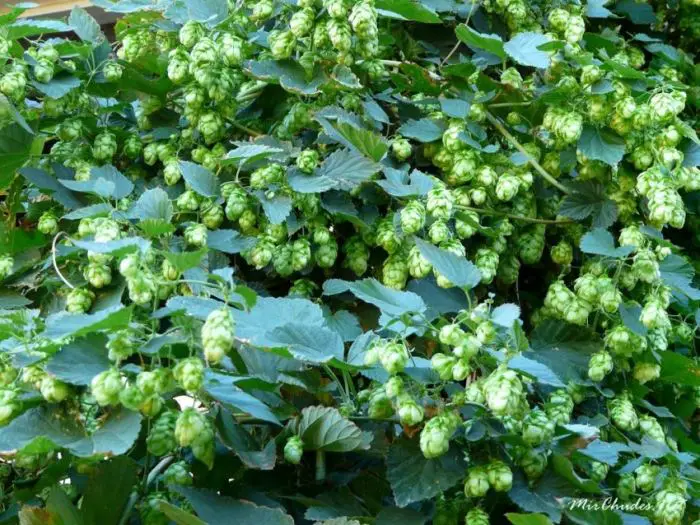
KIRKAZON (Dutchman’s pipe)
The best greenery for large vertical surfaces among landscape designers is considered to be a large-leaved liana – karkazon. The density of the foliage is large and elegant, it can even compete with trimmed shrubs.
And flowers of an extraordinary shape against the background of a dense green fountain seem exotic and unique. Powerful creeping vines reach ten meters in height, sometimes even higher.
The advantages of carcasson include rapid growth, huge size, a crown resembling a tile, contrasting with classic greenery, an unusual color that strikes with its brightness. The unique inflorescences in the form of a curved tube, hidden in the depths of the foliage, amaze with their outlandish appearance.
HONEYSUCKLE
Ornamental types of honeysuckle – fast-growing climbing bushes with abundant flowering are an indispensable attribute in landscaping gardens, plots, parks. There is also honeysuckle with edible fruits.
Plants are highly resistant to even severe frosts. Prefers lighted or semi-shaded areas. Forest honeysuckle species tolerate garden shade well from surrounding trees. Such conditions contribute to the preservation of moisture, which is so necessary for honeysuckle.
Amazing honey plant looks great both in single and group versions. A hedge of honeysuckle will perfectly dilute the garden palette, and edible shrub varieties will be of considerable benefit.
Curly varieties are well suited for the design of arches, arbors. Blooming lianas are even allowed on the ground among large stones.
liana plant
An effective liana with beautiful foliage and fruits, unusual originality and brightness, grows quickly enough. The plant is absolutely unpretentious to living conditions. In autumn, yellow leaves add additional decorative effect to the hedges.
The big disadvantage of this plant lies in its ability to destroy the trees, the trunks of which it wraps around. Its very name bears witness to this. It grows best in areas illuminated by the sun, therefore, it is planted more often near the veranda, thereby creating a pleasant shade.

It grows rather quickly, tolerates winter well, prefers moist loams. Numerous root shoots allow it to multiply quickly.
IVY
A conqueror of heights, some of his shoots reach 100 meters. An evergreen liana that can become a beautiful frame for the walls of buildings, as well as add unusualness to tree trunks. It should not be forgotten that its fruits are poisonous. Therefore, care must be taken when caring for common ivy.
ACTINIDIA
A close relative of actinidia is the kiwi. Its shoots are capable of climbing very high heights. The main advantage is the oblong shape of the berries, small in size (up to three cm), differing in taste and composition of nutrients.
These plants have been preserved since ancient times. They grew on the territory of the Far East in the pre-glacial period (then it was the subtropics).
The peculiarity of the leaves to change their color during development gave it an amazing decorative effect, and the graceful white fragrant flowers only added charm.
MAIDEN GRAPES
An excellent way to hide from the heat is a plant with such a delicate name. Its dense green foliage, covering the gazebo, will give you a refreshing coolness and create a comfortable mood. Flowing stems can climb up a ladder to a height of twenty meters.
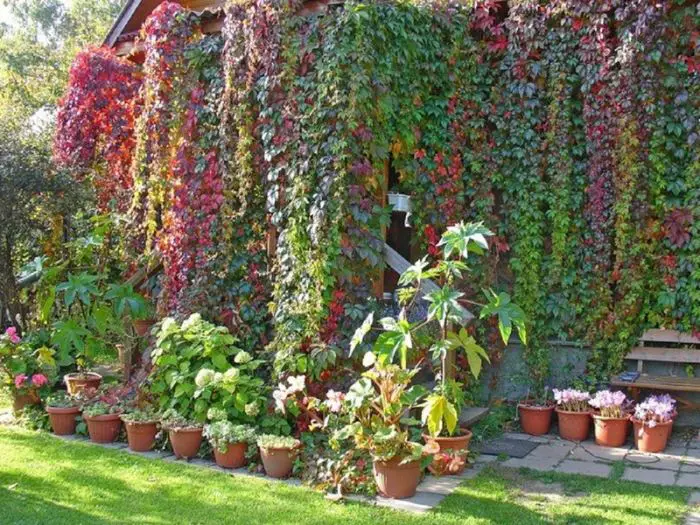
In summer, the leaves of the creeper are covered with a rich green color. In autumn, the deciduous bedspread becomes an incredibly beautiful bright purple color, against the background of which berries glisten with bluish-black beads.
ATTENTION! The berries are poisonous.
This plant has many advantages, but it also has certain disadvantages.
Varieties of perennial climbing plants are represented by the following samples: climbing rose, kampsis, wisteria. They attract gardeners by the fact that after spending a certain amount of time and effort on planting, you can enjoy the results for a very long time.
It must be remembered that overly bright kampsis flowers can attract insects. Therefore, you need to be careful when decorating with this plant.
For those wishing to surprise those around them with a variety of landscapes, annual species of loaches are suitable: morning glory, sweet peas, kobei.
See also Indoor Flowers That Bloom All Year.
WINTER HARDY VINES
Almost all climbing plants are winter hardy. Perennials are popular: wild grapes, kampsis, clematis, wisteria and other varieties.
On special sites on this topic, a huge number of photographs of plants entwining, wriggling, trembling are posted. Seeing the unearthly beauty, you can easily find information about any item you like.
Escaping from the bustle of the city, boxes – many floors, you dream of merging with nature, of peace and comfort. That is why any suburban area or territory of a country house is virgin soil for the implementation of the most incredible fantasies in their improvement. Climbing plants will help transform the site with the help of various supports, arches, structures.
